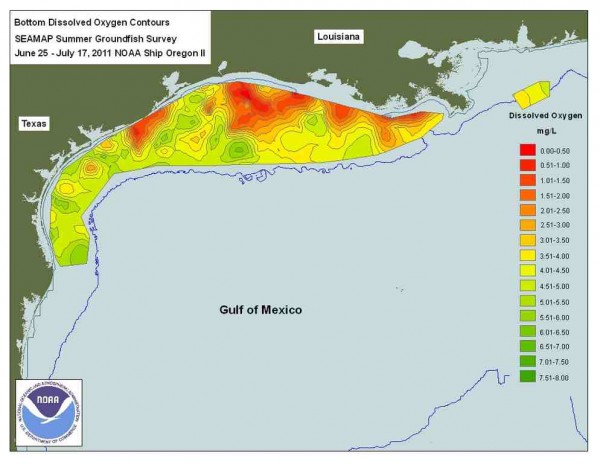Global Warming is Causing More Oceanic Dead Zones
| Ana Verayo | | Nov 11, 2014 02:51 AM EST |
(Photo : NOAA/Wikimedia) The Gulf of Mexico is a prime example of hypoxia or an oceanic dead zone.
Dead zones located in the oceans are growing larger due to the prolonged effects of climate change, according to a new study from the Smithsonian Tropical Research Institute and its Environmental Research Center.
This phenomenon that creates dead zones is called hypoxia and it occurs when a reduced amount of concentrated oxygen creates these zones located in oceans around the world. One of the largest dead zones can be found in the Gulf of Mexico every year as it occurs during spring.
Like Us on Facebook
Dead zones can either be formed naturally or could be formed by chemical runoffs from plants or farms. It affects marine biodiversity since high concentrations of nitrogen and phosphorus promotes the abnormal growth of algae in the ocean. Algae consumes the oxygen needed by other marine species.
NOAA (National Oceanic and Atmospheric Administration) officials said these excess nutrients that run-off from land can stimulate this overgrowth of algae. This decomposition process depletes the oxygen supply that stimulates healthy marine life.
With global warming, oceanic temperature will rise by 3.6 degrees in 94 percent of the world's oceans in the next few decades. This means that warmer waters have a lesser capacity to hold oxygen as opposed to cooler water. This then promotes the occurrence of hypoxia and these dead zones.
Hypoxia has become fairly common as the number of zones has doubled each decade in the last 50 years. According to Keryn Gedan from the University of Maryland, who is also a marine ecologist, these zones have a huge impact on global coastal zones where people live.
This study was published on the journal, Global Change Biology.
TagsGlobal Warming Causes More Oceanic Dead Zones, dead zones, oceanic dead zones, global warming, causes of oceanic dead zones, hypoxia, global warming dead zones oceans world
©2015 Chinatopix All rights reserved. Do not reproduce without permission
EDITOR'S PICKS
-

Did the Trump administration just announce plans for a trade war with ‘hostile’ China and Russia?
-

US Senate passes Taiwan travel bill slammed by China
-

As Yan Sihong’s family grieves, here are other Chinese students who went missing abroad. Some have never been found
-

Beijing blasts Western critics who ‘smear China’ with the term sharp power
-

China Envoy Seeks to Defuse Tensions With U.S. as a Trade War Brews
-

Singapore's Deputy PM Provides Bitcoin Vote of Confidence Amid China's Blanket Bans
-

China warns investors over risks in overseas virtual currency trading
-

Chinese government most trustworthy: survey
-

Kashima Antlers On Course For Back-To-Back Titles
MOST POPULAR
LATEST NEWS
Zhou Yongkang: China's Former Security Chief Sentenced to Life in Prison

China's former Chief of the Ministry of Public Security, Zhou Yongkang, has been given a life sentence after he was found guilty of abusing his office, bribery and deliberately ... Full Article
TRENDING STORY

China Pork Prices Expected to Stabilize As The Supplies Recover

Elephone P9000 Smartphone is now on Sale on Amazon India

There's a Big Chance Cliffhangers Won't Still Be Resolved When Grey's Anatomy Season 13 Returns

Supreme Court Ruled on Samsung vs Apple Dispute for Patent Infringement

Microsoft Surface Pro 5 Rumors and Release Date: What is the Latest?










